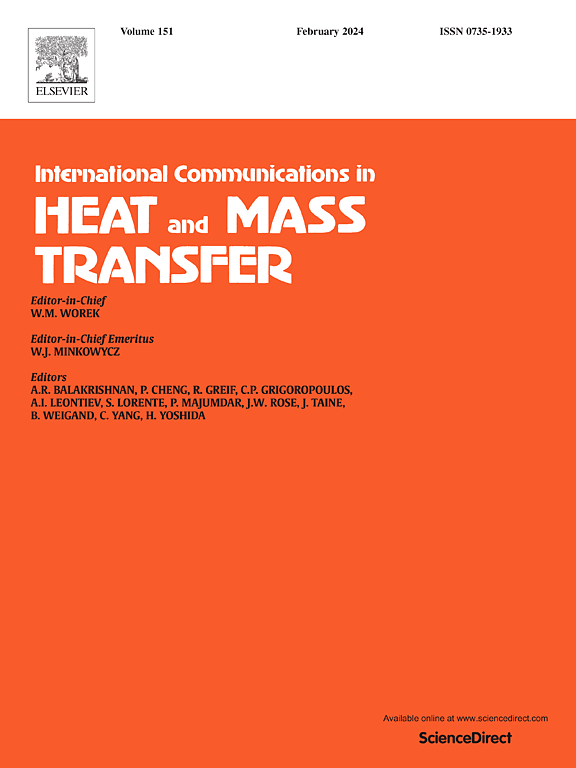Thermal characteristics and optimization of a novel liquid cooling plate with cavities and flow-enhancing fins
IF 6.4
2区 工程技术
Q1 MECHANICS
International Communications in Heat and Mass Transfer
Pub Date : 2025-05-13
DOI:10.1016/j.icheatmasstransfer.2025.109042
引用次数: 0
Abstract
Efficient and reliable thermal management systems are crucial for ensuring the safety and extending the lifespan of electric vehicle batteries. This research proposed a novel liquid cooling plate design that enhances heat dissipation by integrating cavities and flow-diverting fins into the conventional straight-channel structure. A numerical simulation model was developed and validated for accuracy. Six distinct turbulator fin shapes—circular, rectangular, diamond, triangular, shuttle, and droplet—were designed and their thermal performances were evaluated via simulations. Among these designs, the droplet-shaped configuration exhibited superior performance, with a 1.28 °C (3.4 %) reduction in average temperature, a 0.57 Pa (3.3 %) decrease in pressure drop, and a 36.1 % boost in overall performance (HTPF value of 1.361) compared to the traditional straight-channel structure. Furthermore, the impact of cavity quantity and inlet-outlet arrangements on the liquid cooling plate's performance was investigated, revealing that 9 cavities combined with a two-inlet-two-outlet configuration delivered optimal results. To further improve cooling efficiency, design parameters such as the droplet structure's head radius (R), channel width (W), and the spacing of inlets (D₁) and outlets (D₂) were optimized using the Response Surface Method and NSGA-II algorithm. The optimized design demonstrated a 1.97 °C (5.21 %) reduction in average temperature (Tave), a 6.56 Pa (38.7 %) reduction in pressure drop (ΔP), and a remarkable 160 % enhancement in overall performance compared to the baseline straight-channel structure.
一种新型空腔加流翅型液冷板的热特性及优化
高效可靠的热管理系统对于确保电动汽车电池的安全性和延长其使用寿命至关重要。本研究提出了一种新型的液体冷却板设计,通过在传统的直流道结构中集成空腔和导流鳍来提高散热能力。建立了数值模拟模型,并对其精度进行了验证。设计了圆形、矩形、菱形、三角形、梭形和水滴形6种不同形状的紊流翼,并通过仿真对其热性能进行了评价。在这些设计中,液滴形状的结构表现出更优异的性能,平均温度降低了1.28°C(3.4%),压降降低了0.57 Pa(3.3%),总体性能提高了36.1% (HTPF值为1.361)。此外,研究了空腔数量和进出口布局对液冷板性能的影响,结果表明,双入口双出口配置下的9个空腔组合达到了最佳效果。为进一步提高冷却效率,采用响应面法和NSGA-II算法对液滴结构的水头半径(R)、通道宽度(W)、进、出口间距(D 1)等设计参数进行优化。优化后的设计表明,与基准直通道结构相比,平均温度(Tave)降低了1.97°C(5.21%),压降(ΔP)降低了6.56 Pa(38.7%),总体性能提高了160%。
本文章由计算机程序翻译,如有差异,请以英文原文为准。
求助全文
约1分钟内获得全文
求助全文
来源期刊
CiteScore
11.00
自引率
10.00%
发文量
648
审稿时长
32 days
期刊介绍:
International Communications in Heat and Mass Transfer serves as a world forum for the rapid dissemination of new ideas, new measurement techniques, preliminary findings of ongoing investigations, discussions, and criticisms in the field of heat and mass transfer. Two types of manuscript will be considered for publication: communications (short reports of new work or discussions of work which has already been published) and summaries (abstracts of reports, theses or manuscripts which are too long for publication in full). Together with its companion publication, International Journal of Heat and Mass Transfer, with which it shares the same Board of Editors, this journal is read by research workers and engineers throughout the world.

 求助内容:
求助内容: 应助结果提醒方式:
应助结果提醒方式:


